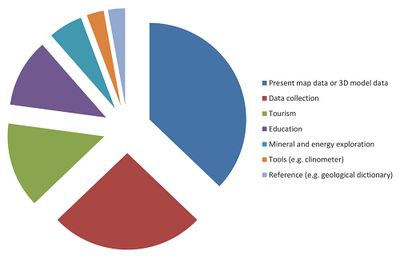OR/14/073 Existing app development
| Bell, P, Shelley, W, Smith, R S, and Tomas, R. 2014. Reusable tools for smartphone apps: innovative activities in the European geological sector. British Geological Survey, OR/14/073. |
 |
One of our key goals was to gain a better understanding of:
- The extent of app development across the geological community
- What purposes these apps are being developed
- What functionality they provided
- What apps are planned for the future
- What mobile platforms are being supported
- Which are seen as the most important platforms to support
- Whether apps are free or have charges
- How long organisations have been involved in app development
- How often these apps are updated
For those not developing apps, we also wanted to understand more about why they had not engaged in such activities and what they perceived to be the barriers to developing apps.
In total, 13 organisations replied that they were actively engaged in app development, telling us about 23 different apps. Figure 3 shows the range of purposes for which these apps are being developed from general tasks such as providing access to mapping data (37%) and a further 26% notably supporting data collection as well as thematic applications. Our review of the app stores provided a similar result.

Examples include:
- BGS’s iGeology which gives access to its digital geology mapping at 1:50 000 scale for the whole of the UK (Figure 4). Appendix 1: Case Study – Mobile app development techniques and strategies at the British Geological Survey (BGS) provides a case study of the BGS approach to mobile app development which gives further details about iGeology.
- i-InfoGeol from the Bureau de Recherches Géologiques et Minières (BRGM) provides similar information for France (Figure 5).
- The Geological Survey of Sweden’s (SGU) GeoMap (Geokartan) is providing the same for Sweden (Figure 6).



Data collection apps in geosciences are also popular. One example is aFieldWork (Figure 7) from the Geological Survey of Denmark and Greenland (GEUS) which provides field geologists working in harsh conditions with a quick and efficient way of recording information on a geological locality in a digital format; allowing for the data to be quickly and efficiently transferred into central databases and Geographical Information Systems (GIS).

Geotourism is another popular purpose. GeoTreats, for example, is an app for finding geotourism sites (Figure 8). Originally initiated by a number of Nordic geological surveys, it is now being extended to other parts of the world.

Appendix 2: Inventory of released apps from European geological surveys obtained from survey responses and review of app stores gives an inventory of released apps either declared in the survey or found in the app stores. It demonstrates a vibrant, mature app development community amongst European geological surveys. The first apps developed were released in 2010 and there has been a steady growth since then, with 4 or 5 new apps being released each year.
All apps developed by geological surveys are made available free of charge. There is one example (iGeology from the BGS) of an app that provides additional chargeable services (in app purchases) thus offering a ‘freemium’ approach to information delivery. We can, to some extent, see that European geological surveys understand the app market and appreciate how the technology can help them meet and advance their information delivery requirements and obligations. Apps are used to promote the work of geological surveys and to engage in collaboration and partnership-working, rather than being seen as a direct method of revenue generation.
The majority of apps focus on providing existing functionality more conveniently to users on the move. There are also examples of more innovative use of the mobile platform to provide greater functionality and more interactive information delivery. For example the BGS’s iGeology 3D app uses augmented reality to bring the geology map to life (Figure 9). Highly innovative, this mobile app utilises the GPS, camera, tilt sensor, compass and motion detector functions on tablets and smartphones to paint a geology map over the landscape as you view it through your device’s camera.

Survey responses also indicate that many more apps are in development and that geological surveys are continuing to expand their portfolio of apps, extending the functionality they provide.
 |